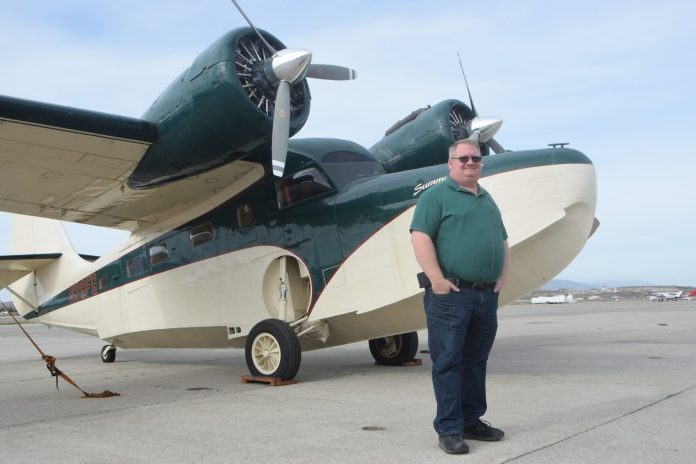
You can’t head down to the Hollister Municipal Airport and catch a flight to Hong Kong. What you will find is a city-owned airport that’s CalFire’s local airbase, a home for gliders, flying lessons, helicopter rides, and a home for private aviators who fly anything from four-seater propeller-powered aircraft to classic jet fighters.
The airport is also working to refit one of its buildings to lease as an onsite restaurant, which will rent for about $3,000 a month beginning in December.
And it’s all done without a cent of city general fund money. With the help of Airport Director Mike Chambless, the growing facility turns a yearly profit.
For a local general aviation airport, the Hollister Municipal Airport is flying high.
“We have amazing things happen here almost on a daily basis,” Chambless said.
The Hollister Municipal Airport operates from an enterprise fund, which is separate from the city’s general fund. While city sales and a portion of property taxes go into the general fund, which goes to fund police, fire, parks, and streets, the Hollister airport is funded by its users in the form of rent and an eight-cents-per-gallon tax on airplane fuel.
“The airport gets zero money from taxes on the citizens of Hollister; the airport operates solely from its own fund,” Chambless said. “If you don’t have anything to do with the airport, you’ve never paid a penny for it.”
With an operating budget of just $1 million a year, the Hollister Municipal Airport breaks even, and annually puts $100,000 into a reserve account. The airport received $18 million in federal grants in 2016 to rehabilitate its runway because it was able to put up the required $1.8 million, or 10 percent, in matching funds. Chambless said he makes sure to put aside at least $40,000 every year to match federal grants. And through several capital improvement funds, the Hollister airport is prepared for the unexpected.
There’s more on the horizon. Next year’s federal grant money, $6 million, will be used to build a new 2,000-foot taxiway that will eliminate runway cross traffic, a significant safety improvement.
“A lot of airports lose their grants because they don’t have the matching funds to pay their portion of the necessary funds,” Chambless said. “I just met with the Federal Aviation Administration, and they are very pleased with the way we operate.”
The mix of clients at the Hollister airport is an eclectic assortment of weekend flying enthusiasts, private businesses and public safety organizations like CalFire. Most tenants rent the 130 T-hangars for smaller Cessna airplanes for about $400 a month. Tenants for the 15 to 20 larger hangars include Aris Helicopters and Sky Dive Hollister.
To help save space, T-hangars are built to accommodate the wings of a plane in front and narrow in the back to fit the rear end of the airplane. Like a puzzle or a piece in Tetris, the T-hangar configuration allows the airport to maximize its space.
Most clients at Hollister airport are local flyers from as near as Santa Cruz and Santa Clara counties and as far as Oakland and beyond. Some clients fly privately owned Czechoslovakia, L-39s and L-29s fighter jets, while others stick to the smaller Cessna aircraft or gliders.
Flying a fighter jet may sound cool, but it’s not a hobby for average weekend flying enthusiasts.
“You can get one for $300,000. Of course, as soon as you start the engine, $100 bills are coming out of the tailpipe,” Chambless said. “It will cost about $1,500 just to taxi it down the runway.”
The Hollister Municipal Airport dates back to 1912, as a small airstrip in a pasture in the mid-1920s. It was renamed Turner Field when it was bought by Everett Turner in 1941. As the prospect of war loomed, the U.S. Navy turned it into the Navy Air Auxiliary Station, which housed up to 300 Navy personnel undergoing advanced weapons training. The Navy turned the facility over to the City of Hollister on Dec. 9, 1947.
Chambless, who also runs the city’s Public Works Department, runs a tight ship. With four permanent employees, duties at the Hollister airport include mowing grass, repairing runways and maintaining lights and reflectors. Mowing at Hollister airport is an arduous task, taking up to four days of all-day work to complete in the wet season.
“We’re basically property managers,” Chambless said. “I don’t get involved in the way the planes fly. We repair the buildings, fix the pavement, paint and stuff like that. But if there’s an emergency I get called, and depending on the nature of the emergency; I need to take care of it.”
Within the next six years, CalFire plans to expand its Hollister base to house an additional four aircraft, including the giant four-engined Lockheed C-130.
The Hollister airport has two runways, a 4,000-foot runway for takeoffs and landings during afternoons when crosswinds are high, and a longer 6,350-foot main runway. All included, the Hollister airport spans 300 acres.
“We can land anything once,” Chambless said. “Different planes weigh different amounts, so if a 747 landed there, it would stop, but it would damage the runway. Our runway is built to handle C-130s full of fire retardant. We can handle a 737, all day long.”









